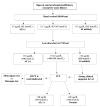Central Adrenal Insufficiency: Etiology and Diagnostic Approach
- PMID: 39713897
- PMCID: PMC11730094
- DOI: 10.4274/jcrpe.galenos.2024.2024-7-2-S
Central Adrenal Insufficiency: Etiology and Diagnostic Approach
Abstract
Central adrenal insufficiency (CAI) occurs due to a pituitary gland disorder (secondary AI) or hypothalamic dysfunction (tertiary AI). It is a potentially life-threatening condition that has many congenital and acquired causes. Adrenocorticotropic hormone deficiency may be isolated or more commonly it can be accompanied by other pituitary hormone deficiencies or midline defects. The signs and symptoms of CAI are associated with glucocorticoid deficiency. A three-step diagnostic approach including dynamic stimulation tests is recommended in the evaluation of patients with suspected CAI. Here, members of the ‘Adrenal Working Group’ of ‘The Turkish Society for Pediatric Endocrinology and Diabetes’ present an evidence-based review with good practice points and recommendations for etiology and diagnostic approach in children and adolescents with CAI.
Keywords: ACTH; Central adrenal insufficiency; children; guideline; secondary.
©Copyright 2025 by Turkish Society for Pediatric Endocrinology and Diabetes / The Journal of Clinical Research in Pediatric Endocrinology published by Galenos Publishing House.
Conflict of interest statement
Conflict of interest: None declared
Figures
Similar articles
-
Central adrenal insufficiency in children and adolescents.Best Pract Res Clin Endocrinol Metab. 2018 Aug;32(4):425-444. doi: 10.1016/j.beem.2018.03.012. Epub 2018 Apr 10. Best Pract Res Clin Endocrinol Metab. 2018. PMID: 30086867 Review.
-
Evaluation of adrenal function in patients with growth hormone deficiency and hypothalamic-pituitary disorders: comparison between insulin-induced hypoglycemia, low-dose ACTH, standard ACTH and CRH stimulation tests.Eur J Endocrinol. 2005 May;152(5):735-41. doi: 10.1530/eje.1.01911. Eur J Endocrinol. 2005. PMID: 15879359
-
SFE/SFEDP adrenal insufficiency French consensus: Introduction and handbook.Ann Endocrinol (Paris). 2018 Feb;79(1):1-22. doi: 10.1016/j.ando.2017.12.001. Epub 2018 Jan 12. Ann Endocrinol (Paris). 2018. PMID: 29338844
-
Adrenal insufficiency - causes and laboratory diagnosis.Biomed Pap Med Fac Univ Palacky Olomouc Czech Repub. 2025 Jun;169(2):73-81. doi: 10.5507/bp.2024.033. Epub 2024 Oct 7. Biomed Pap Med Fac Univ Palacky Olomouc Czech Repub. 2025. PMID: 39380209 Review.
-
Should we routinely assess hypothalamic-pituitary-adrenal axis in pediatric patients with Prader-Willi syndrome?Front Endocrinol (Lausanne). 2024 Jun 27;15:1406931. doi: 10.3389/fendo.2024.1406931. eCollection 2024. Front Endocrinol (Lausanne). 2024. PMID: 38994010 Free PMC article.
References
-
- Vallette-Kasic S, Brue T, Pulichino AM, Gueydan M, Barlier A, David M, Nicolino M, Malpuech G, Déchelotte P, Deal C, Van Vliet G, De Vroede M, Riepe FG, Partsch CJ, Sippell WG, Berberoglu M, Atasay B, de Zegher F, Beckers D, Kyllo J, Donohoue P, Fassnacht M, Hahner S, Allolio B, Noordam C, Dunkel L, Hero M, Pigeon B, Weill J, Yigit S, Brauner R, Heinrich JJ, Cummings E, Riddell C, Enjalbert A, Drouin J. Congenital isolated adrenocorticotropin deficiency: an underestimated cause of neonatal death, explained by TPIT gene mutations. J Clin Endocrinol Metab. 2005;90(3):1323–1331. doi: 10.1210/jc.2004-1300. - DOI - PubMed
-
- Couture C, Saveanu A, Barlier A, Carel JC, Fassnacht M, Flück CE, Houang M, Maes M, Phan-Hug F, Enjalbert A, Drouin J, Brue T, Vallette S. Phenotypic homogeneity and genotypic variability in a large series of congenital isolated ACTH-deficiency patients with TPIT gene mutations. J Clin Endocrinol Metab. 2012;97:E486–E495. - PubMed
Publication types
MeSH terms
Substances
LinkOut - more resources
Full Text Sources

